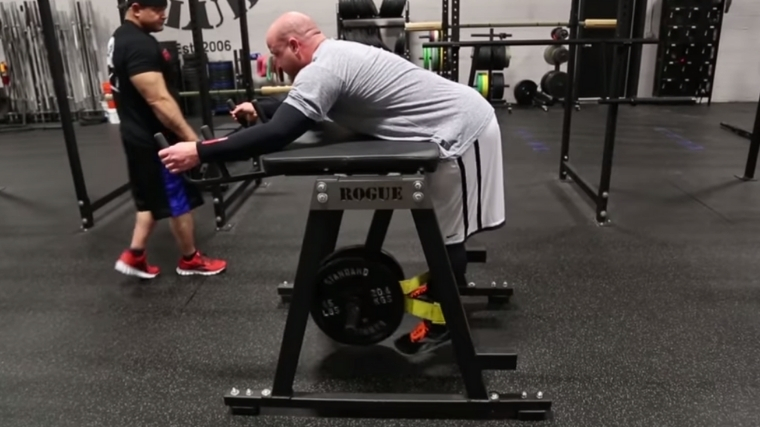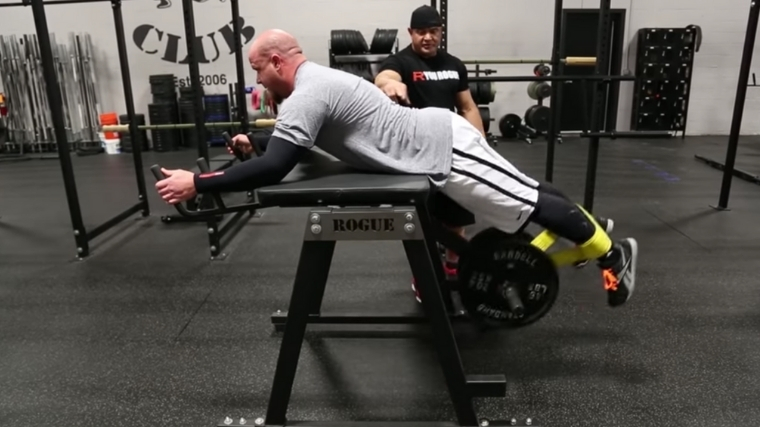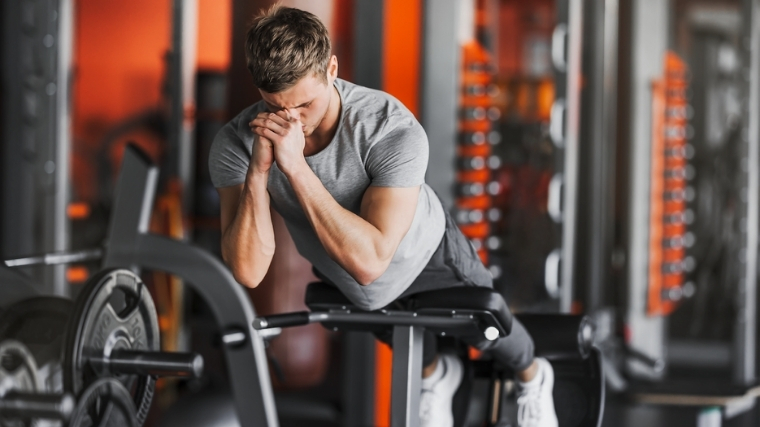Your lower back, glutes, and hamstrings are the foundation of your body. Though each muscle serves a function on its own, combined, this trio makes up a decent portion of your core and supports your spine. And few moves build up these muscles quite like the reverse hyperextension — a movement that has you extend your legs up behind you as you lay face down on a bench. It’s simple, effective, and easily scaled.
Below, we’ll go over how to do the reverse hyperextension and break down some of the more popular variations and alternatives.
- How to Do the Reverse Hyperextension
- Benefits of the Reverse Hyperextension
- Muscles Worked by the Reverse Hyperextensionå
- Who Should Do the Reverse Hyperextension
- Reverse Hyperextension Sets, Reps, and Programming Recommendations
- Reverse Hyperextension Variations
- Reverse Hyperextension Alternatives
- Frequently Asked Questions
Editor’s Note: The content on BarBend is meant to be informative in nature, but it should not be taken as medical advice. When starting a new training regimen and/or diet, it is always a good idea to consult with a trusted medical professional. We are not a medical resource. The opinions and articles on this site are not intended for use as diagnosis, prevention, and/or treatment of health problems. They are not substitutes for consulting a qualified medical professional.
How to Do the Reverse Hypertension
Below is a step-by-step guide on how to properly set up and perform the reverse hyperextension.
Step 1 — Get Set Up

Assume a prone position either in a hyperextension machine or on the glute-ham raise developer. If you don’t have access to either piece of equipment, you can lay down on a flat bench and wrap your arms underneath it to stay in place. Whichever piece of equipment you choose, your legs should be dangling off the end of the bench.
Form Tip: Your hips should be set at the end of the pads so that they can flex freely without the lower back extending and flexing excessively.
Step 2 — Lift Your Legs

Brace your core and straighten your legs. Flex the muscles in your hamstrings, glutes, and lower back to raise your legs from below your hip line to above the hips. Hold the top position of the movement for one second, and then lower your legs back down with control.
Form Tip: It’s ok to use a little momentum to get your legs from the starting position to the contracted position. Do not, however, jerk your lower back to raise your legs. Let your legs gently bounce back up after your first rep.
Benefits of the Reverse Hyperextension
Below are three benefits of performing reverse hyperextensions (any of the below variations). Note: Use the reverse hyperextension machine if you can, as it lets you maximize the three benefits below comfortably and with the most optimal range of motion.
More Glutes and Hamstring Isolation
You can build a strong backside with various glute exercises — the good morning, Romanian deadlift (RDL), and even hip thrust. Those exercises are effective, but they require a lot of weight, and, in the case of the RDL, you’re limited by your grip strength (even with lifting straps). The reverse hyperextension lets you work your hammies and glutes without taxing your grip or loading up your joints. Reverse hypers — as they’re commonly called — are to your posterior chain what the pull-up is to your upper back muscles and lats.
Better Hip Extension
Your lower back, hamstrings, and glutes are the drivers of this movement, but your hips are extending powerfully during each repetition. As a result, you will become more effective at hip-hinging, a vital movement for deadlifts and clean & jerks. If you’re new to lifting, the reverse hyperextension is a great way to ease into the hip hinge. If you can’t perform a hip hinge with a neutral spine, the reverse hyperextension can develop proper patterning and muscle strength so you can transition to movements such as good mornings, RDLs, and squats.
Injury Prevention for Lower Back
Lower back injuries are common in hip hinge-based movements. It’s taxing to maintain a natural spine while in motion. Increasing the strength and function of the glutes and hamstrings (through teaching proper hip flexion and extension in a fixed position) can help athletes develop better movement mechanics, muscular strength, and endurance, increasing injury resilience during training sessions and competition.
Muscles Worked by the Reverse Hyperextension
Here are the main muscles and their function during the reverse hyperextension.
Hamstrings
The hamstrings are active during this movement and help to extend the hip under load. In addition, the lifter must forcefully resist knee extension (rather, knee extension) under load, furthering the isometric strength of the hamstrings.
Gluteals
The glutes (glutes) are highly active in this movement and extend the hips to bring the legs and loads upwards (away from the floor). This exercise is ideal for increasing glute strength and activation.
Spinal Erectors
The spinal erectors (lower back) work isometrically to keep the lifter stable during this movement. If a lifter has an extra mobile lower back, meaning it goes into flexion and extension every repetition, they may be feeling pain in the lower back (which is not correct).
Who Should Do the Reverse Hyperextension?
Here’s a breakdown of different people who can benefit from reverse hyperextension and how.

[Read More: The Best Ab Exercises & Workouts, According to a CPT]
Strength and Power Athletes
- Powerlifters and Strongman Athletes: Strongmen and powerlifters are constantly under heavy load, so strengthening the posterior chain — a key support system — will help improve their stability and core strength. Also, the extreme flexion of the reverse hyperextension can help to decompress the spine, which may alleviate undo back pain.
- Olympic Weightlifters: Weightlifters can use this exercise to help build a healthier back, increase lower back strength, and do so without taxing the body more than you need to.
General and Functional Fitness
If you’re focusing on building up the hamstring, glutes, and/or lower back, you can sub in reverse hyperextension for hyperextensions or hinging work. This is particularly helpful for lifters who cannot do those movements due to lower back stiffness or pain, as the reverse hyper can act as a form of spinal decompression.
Reverse Hyperextension Sets, Reps, and Programming Recommendations
Here are four set and rep schemes you can use to target different training modalities.
To Improve Form
If your goal is to enhance your hinging ability, you’ll want to keep the volume moderate and stick with just your body weight. Do three to four sets of eight to 10 repetitions with light to moderate loads at a controlled speed. Rest as needed.
To Build Muscle
If the goal is muscle hypertrophy, stick with higher rep-based programming using roughly 25% of your one-rep max best back squat. A reverse hyperextension machine will be equipped with a mechanism that allows you to load weight. Perform three sets of 12-15 reps, keeping rest periods 45-90 seconds.
To Increase Strength
You’ll follow a similar protocol to the muscle-building scheme above, but with slightly fewer reps and slightly more weight. Do three to four sets of eight to 10 reps using a load that’s equal to about 50% of your one-rep max back squat. Rest as needed.
To Maximize Muscle Endurance
The focus here is all about taxing the muscles. Start with just your body weight and do two to four sets of 15-20 reps. You can add a little bit of weight onto the machine, sticking with that same rep range. Rest just 30 to 45 seconds between sets.
Reverse Hyperextensions Variations
Below are three reverse hyperextension variations that coaches and athletes can use to keep training varied and progressive.
Tempo Reverse Hyperextension
Lift and lower your legs to a tempo to increase time under tension, movement awareness and potentially increase a lifter’s ability to activate muscles. As a plus, you won’t need to load the movement with weight.
Banded Reverse Hyperextension
Rather than using bodyweight or a hyperextension machine, a lifter can use resistance bands to load the movement when a machine is not available and increase muscle engagement and under tension during this movement (accommodating resistance).
Reverse Hyperextension Isometric Holds
Performing isometric holds/pauses at the top of the movement s a great way to increase muscle activity during the extension aspect of this lift. In doing so, you can challenge a lifter’s upright torso positioning, necessary for front-loaded squats, back squats, thrusters, running, and more.
Reverse Hyperextensions Alternatives
Below are three reverse hyperextension alternatives coaches and athletes can use to increase glute and hamstring development, address weaknesses, and build muscle.
Good Morning
The good morning is a lower back exercise that also targets the hamstrings, and glutes. This exercise is a good choice for lifters looking to increase back and hip strength. The primary difference is that this exercise places slightly more emphasis on the lower back and spinal erectors.
Glute Ham Raise (GHD)
The glute-ham raise or glute hamstring developer is an exercise that increases muscle hypertrophy, endurance, and strength in a very similar movement as the reverse hyperextension. The primary difference is that this exercise places more tension on the lower back.
Hip Thrust
The lying down hip thrust is a great option for lifters who do not have access to a reverse hyperextension machine and/or are looking to really loud the gluteal muscles. This movement is almost exclusively used for glute development and strength.
FAQs
Can you do reverse extensions at home?
You can perform the reverse hyperextension by laying on a raised surface and performing them with your legs hanging off. This could be a couch, table, or any other stable and comfortable surface. You could also do them on the ground. However, the more your legs can be hanging underneath you, the better, as this increases the range of motion and therefore benefit of the movement.
What is the difference between hyperextensions and reverse hyperextensions?
The reverse hyperextension as you dangle your legs off of the apparatus while the hyperextension has you extend your torso. The reverse hyper targets more of the glutes and hamstrings while the hyperextension focuses more on the lower back.
How heavy can you train the reverse hyperextensions?
Generally speaking, you can lift as heavy as you can while still maintaining form and technique. Refer to the recommendations section above for estimates on how heavy to train according to your overall training goal.
Featured image: Courtesy of Rogue Fitness on YouTube